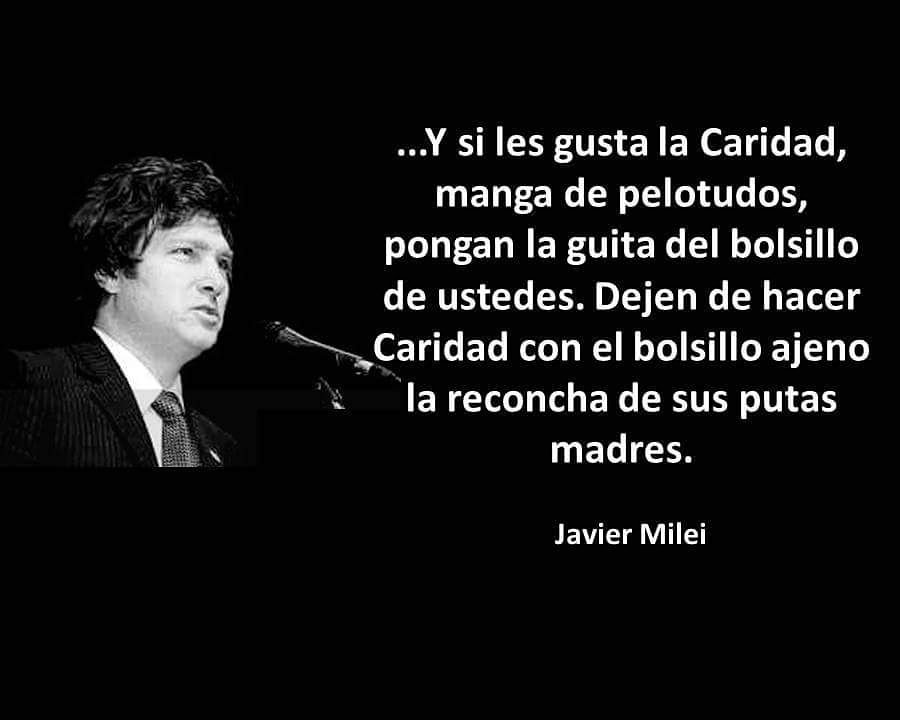|
|
General: CATEDRAL METROPOLITANA DE BUENOS AIRES MADELEINE PALAIS BOURBON PARIS
Choisir un autre rubrique de messages |
|
Réponse |
Message 1 de 42 de ce thème |
|
Catedral metropolitana de Buenos Aires
La Catedral Metropolitana de Buenos Aires (de la Santísima Trinidad) es el principal templo católico de Argentina. Se encuentra ubicada en el barrio porteño de San Nicolás, en la intersección de la calle San Martín y la avenida Rivadavia, en frente a la plaza de Mayo.
 Plano del conjunto catedralicio.  Catedral Metropolitana de Buenos Aires, Mausoleo de San Martín.
Cuando Juan de Garay llegó desde Asunción a fundar la ciudad de la Trinidad el 11 de junio de 1580, destinó para la iglesia mayor el mismo cuarto de manzana que ocupa hoy en día la catedral. En el acta de fundación se lee: "hago y fundo en el asiento una ciudad la cual pueblo con los soldados y gente que al presente he traído para ello, la iglesia de la cual pongo por advocación de la Santísima Trinidad, la cual sea y ha de ser iglesia mayor parroquial". En lo que atañe a la jurisdicción eclesiástica, la nueva ciudad dependía de la diócesis del Río de la Plata, creada por Paulo III el 1.º de julio de 1547 con sede en Asunción.
 Vista nocturna de la Catedral Metropolitana de Buenos Aires
Pasaron cuatro años desde la fundación de la ciudad hasta que los vecinos iniciaron la construcción de la iglesia matriz; como encontraron toda la cuadra vacía, la edificaron en el solar que había pertenecido a Juan de Garay, que ya había sido muerto a manos de los timbúes; se trata del solar donde actualmente existe la sede central del Banco de la Nación Argentina, y se terminó de construir en 1587. En 1591 se le cayó el techo, por lo que hubo que reedificarla; obra que se paralizó cuando la Real Audiencia de Charcas ordenó que se mudase al solar correcto. Allí, fray Martín del Barco Centenera levantó una pequeña y precaria capilla, que ejerció como iglesia parroquial con muchas limitaciones; pero al menos estaba en el lugar correcto.1
E
Su sucesor fue el trinitario fray Pedro Fajardo, apostólico y santo prelado, que como es de suponer puso todo su empeño en la conclusión de las obras de la catedral. En carta de 20 de agosto de 1721 comunicaba el obispo al rey que ya se había dado cima a una de las torres y estaba interesado en levantar la segunda.
Pero al año siguiente -1722- la techumbre del templo se iba deteriorando de tal modo, que se temía su derrumbamiento. Enfermo y en cama, el obispo pidió al Cabildo Eclesiástico que se hiciese cargo de la obra. Ya se supone que la primera dificultad que se presentó fue la carencia de recursos económicos. El Cabildo, en tal coyuntura, dirigió un exhorto a los miembros del Ayuntamiento a quien competía, también, poner manos en ese asunto. Pero por un motivo u otro –algunos verdaderamente fútiles- se pasaron dos años sin que se hubiera adelantado nada. Entonces es cuando surge la figura del arcediano Marcos Rodríguez de Figueroa y con él las cosas entraron por la vía recta. A su actividad y celo por la causa de Dios se debe la terminación de la obra de la catedral. Para ese efecto, la real hacienda puso 1.800 pesos y él 3.000 de sus propios haberes; el arcediano consiguió 1.500 del vecindario e hizo un empréstito de 2.500 y 1.000 provinieron del cabildo secular. Se terminó el trabajo de las torres, el arreglo de las naves y el del pórtico; además, en 1725, un tal Tomás Trupp, hizo una donación de 5.000 pesos para las campanas. Esta fue la cuarta catedral.
Al morir Fray José de Peralta, se reunió el Cabildo y eligió vicario capitular al Dr. Bernardino Verdún de Villaysán, una de cuyas principales ocupaciones –y las del Cabildo- fue el mejoramiento de la catedral. Como primera providencia, tanto el vicario capitular como el Cabildo, hicieron traer de Potosí 400 libras de oro y los elementos necesarios para hacer dorar el retablo; luego se ocuparon de blanquear la sacristía mayor, los pilares del cañón principal, de todas sus capillas y del bautisterio. Además de ello, el Cabildo se ocupó en hacer alargar el presbiterio, ensanchar la mesa del altar mayor, cuyo retablo compuso en sus dos caras: tampoco olvidaron los señores canónigos la sala capitular y el archivo, que se preocuparon de ordenar y componer según las normas de la época de tal manera que no sufrieran deterioro los documentos y papeles que en él se habían de guardar. El Cabildo tuvo que sufragar los gastos que traían consigo estos arreglos y adecentamientos. Un vecino de la ciudad, nombrado Agustín de García, donó 500 pesos para el dorado y pintura al óleo del coro principal. Esta fue la quinta catedral.
LAcuarela de la catedral hacia 1817.
La quinta catedral no fue la definitiva pues a las 9 de la noche del 23 de mayo de 1752 se derrumbó una parte de ella y entre las seis y las diez de la mañana del día siguiente se desplomaron, según informe del gobernador José de Andonaegui "las tres bóvedas de iguales naves". El obispo, don Cayetano Marcellano y Agramont informaba al rey que fue preciso "derribarla enteramente por la poca firmeza de las paredes que han quedado y empezar su fábrica desde los cimientos con más solidez y extensión que los de la antigua, que por su cortedad no parecía catedral".
Transcurridos tres años, sin contar con la autorización real y sin haber enviado los planos para su autorización, y con el total apoyo del Cabildo Eclesiástico, empezó el obispo a levantar la nueva catedral, la actual, según los planos de un arquitecto nombrado Antonio Masella, de origen saboyano. El célebre vasco y hombre de empresa Domingo de Basavilbaso, hombre de confianza del obispo y bienquisto de la ciudad, en 1754 se hizo cargo de la tesorería y dirección de la obra del nuevo templo. La nueva catedral, según el plano de Masella, sería de cruz latina, con tres naves y seis capillas laterales a ambas.
 La Catedral hacia 1829, por Carlos Pellegrini.
La catedral se fue edificando con los bienes de la Iglesia y con la cooperación económica del pueblo. Las obras, de a poco, se iban realizando, tanto que en 1758 se pudo inaugurar la llamada nave de San Pedro, la que se halla a la derecha de la puerta de entrada, y también el nuevo bautisterio. Pero, aunque un poco tardía, la ayuda real empezó a llegar en 1760.
Don Cayetano Marcellano y Agramont, que tanto había hecho por la nueva catedral en 1759, tuvo que dejar el gobierno de esta diócesis por haber sido trasladado a la sede arzobispal de Charcas. Su sucesor, el porteño José Antonio Basurco (1760-61) ocupó solo un año la sede bonaerense, pero hizo también su obra contribuyendo a la prolongación del templo al donar el terreno de una casa, contigua a la iglesia, que pertenencia de su hermana, doña María Josefa Basurco, tasado en 7.500 pesos, que pagó de su peculio personal.
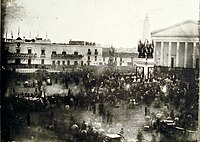 En este daguerrotipo de 1854 se aprecia la catedral aún sin friso.
Una dificultad sobrevino en 1770, en que al detectarse grietas en la media naranja o cúpula, fue necesario proceder a su demolición. Al cabo de siete años las obras tuvieron que suspenderse porque también se había suspendido la ayuda estipulada en 6.000 pesos. En 1778 fue demolido el pórtico porque no concordaba con las proporciones del edificio de la catedral; también fueron demolidas las torres por no estar de acuerdo con el estilo del templo.
Fue el penúltimo obispo de Buenos Aires, don Manuel Azamor y Ramírez, quien puso cima a las obras del templo catedralicio en lo que se refiere a lo principal de él y lo inauguró el 25 de marzo de 1791, treinta y ocho años después de iniciada su reconstrucción en 1753. La catedral fue consagrada en 1804 por el último obispo de la era hispánica don Benito de Lué y Riega, quien se empeñó en agregarle lo que aún le faltaba: el frontis y las torres. Las obras se comenzaron en 1804, pero en 1807 hubieron de suspenderse por falta de numerario.
 La Catedral con su nuevo friso, fotografía de Gonnet, 1864.
Pasados los años, independizado ya el país de España, el gobierno de Martín Rodríguez en la persona de su ministro Bernardino Rivadavia puso un gran interés en la conclusión de las obras de la catedral. Al respecto, se sabe con certeza que las del frontis se comenzaron el mes de enero de 1822. En este punto hay que salir al paso de un error que ha tomado cuerpo. Se dice que el encargado de terminar, el francés Próspero Catelin, al levantar la columnata del frontis se inspiró en la Iglesia de la Madeleine de París. Pero si confrontamos una y otra, constatamos en seguida que en realidad no fue así. En primer lugar, la Madeleine tiene ocho columnas y la catedral de Buenos Aires doce. En segundo término, las obras de la Madeleine se concluyeron el año 1842 y por tanto no podía tomarse como modelo lo que aún estaba por concluir en 1822. Según el arquitecto Buschiazzo más bien parece que Catelin "se hubiese inspirado en el Palais Bourbon, cuya fachada tiene también doce columnas y que acababa de ser terminado por el arquitecto Poyat en 1807". Las doce columnas, número con el que quiso representar a los doce apóstoles, se concluyeron en 1823, aunque sin capiteles y sin las esculturas del tímpano. Las columnas se revocaron tardíamente, en 1862, y ese mismo año, el escultor francés Dubordieu realizó esculturas del tímpano en que representa al encuentro de José y sus hermanos, alusión al encuentro de los argentinos después de la batalla de Pavón en 1861.2 Las columnas son de orden corintio.
 La Curia Eclesiástica, a la derecha de la Catedral (ca. 1920)
En 1856, el Gobierno de Buenos Aires dictó una ley para la construcción de la demorada Curia Eclesiástica. Fue proyectada por Pedro Fossati en estilo italianizante y se edificó en el terreno lindante hacia el este, dejando el espacio del camposanto de por medio. Contaba con planta baja y dos pisos y su interior estaba organizado alrededor de un patio central. Fue concluido por el ingeniero Charles Pellegrini, y habilitado en 1862.
La Catedral fue declarada monumento histórico el 21 de mayo de 1942. Su curia fue incendiada en 1955 en respuesta al Bombardeo de la Plaza de Mayo, que ocasionó más de 308 muertos y alrededor de 800 heridos.3 En 1994, comenzó una intensiva obra de restauración y puesta en valor del templo dirigida por el arquitecto Norberto Silva. La finalización de los trabajos fue celebrada el 13 de octubre de 1999 con una misa brindada por el arzobispo Jorge Bergoglio, a la cual asistió entre otros el presidente Carlos Menem.4
En 2013 en ocasión del Sesquicentenario de la inauguración del alto relieve de la fachada, el Gobierno de la Ciudad junto a los equipos de la Catedral, restauró el pórtico en el marco del Plan Microcentro. Asimismo se inauguró una muestra permanente de Jorge Bergoglio, que fue Arzobispo de Buenos Aires y el encargado de conducir la Arquidiócesis. Allí el visitante podrá encontrar objetos personales y litúrgicos que utilizó durante los 15 años de su ministerio pastoral en la Ciudad.
 Catedral Metropolitana.
En el suelo del atrio, frente a la puerta central, se halla una estrella de ocho puntas, que indicaba el punto de apoyo para la nivelación de la ciudad. En efecto, cuando se efectuó la nivelación de las calles se tomó la altura del peristilo de la Catedral como "Cota 0". Hay que tener en cuenta que a fines del siglo xix el peristilo de la Catedral estaba al ras de la calzada y la altitud de la calle Rivadavia como la de Plaza de Mayo fue rebajada. Esta rebaja ha quedado evidenciada por las cinco gradas de la escalinata que fue necesario agregar al umbral del templo.5 Por decreto del 13 de agosto de 1899 se tomó como nueva cota 0 el nivel del Riachuelo en su desembocadura, y así el antiguo nivel de la Catedral quedó a 19,0081 m arriba del nuevo cero.6
M
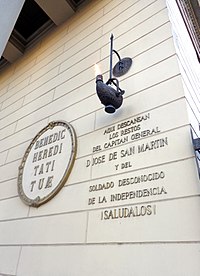 Lámpara votiva en el frente de la Catedral.
La fachada principal, de estilo neoclásico, se inspira en el frontis del Palacio Borbón de París. Fue diseñada en 1822 por los franceses Próspero Catelin y Pedro Benoit.
Consta de un frontis y de doce columnas que simbolizan a los Apóstoles. La ornamentación del frontis y el orden arquitectónico de las columnas fueron definidos por el escultor francés José Dubourdieu. Quién realizó los capiteles corintios y el bajorrelieve del frontispicio, trabajos concluidos hacia 1863. El bajorrelieve representa el encuentro de José con su padre Jacob y sus hermanos en alusión al encuentro de los argentinos después de la batalla de Pavón en 1861.8
La belleza de la construcción neoclásica se encuentra en la composición armoniosa de los escenarios, sin caer en los excesos.9
Su configuración es poco usado en las catedrales, dándole un parecido más cercano a un templo griego –con columnas, arcos, frontispicios triangulares– que al clásico edificio católico.8 Esta configuración exterior, no se condice con la configuración espacial, ni el estilo, del interior.
 Mausoleo del General San Martín en el interior de la Catedral.  Monumento al Arzobispo León Federico Aneiros
Desde la nave lateral derecha se accede al mausoleo que guarda los restos del General San Martín, ubicado en su cuarta casilla, que está allí desde 1880, y que fue obra del escultor francés Carrier Belleuse (inspirado en el eclecticismo francés, que imperaba en Europa en ese momento).
En el interior, la cúpula, el presbiterio, los brazos del transepto y la nave central, fueron decorados por el italiano Francesco Paolo Parisi con unos frescos renacentistas, pero se perdieron a causa de la humedad.
En la capilla San Martín de Tours (ubicada en el ala izquierda) está el monumento al Arzobispo León Federico Aneiros, una obra del escultor Victor de Pol, que es un mausoleo en mármol de Carrara y piedra, con la figura del prelado arrodillado en su centro. Las catorce pinturas del Vía Crucis son obra de Francesco Domenighini, otro italiano, y originalmente se encontraban en la Iglesia del Pilar.
El
|
|
|
|
Réponse |
Message 28 de 42 de ce thème |
|
|
|
|
Réponse |
Message 29 de 42 de ce thème |
|
|
|
|
Réponse |
Message 30 de 42 de ce thème |
|
|
|
|
Réponse |
Message 31 de 42 de ce thème |
|
|
|
|
Réponse |
Message 32 de 42 de ce thème |
|
Javier Milei recibió al Presidente Emmanuel Macron
Los mandatarios saludaron desde el balcón de la Casa Rosada.
El Presidente Javier Milei recibió esta mañana en el Salón de los Bustos de Casa Rosada a su par de la República Francesa, Emmanuel Macron, en su segunda visita oficial bilateral a un país de Latinoamérica.
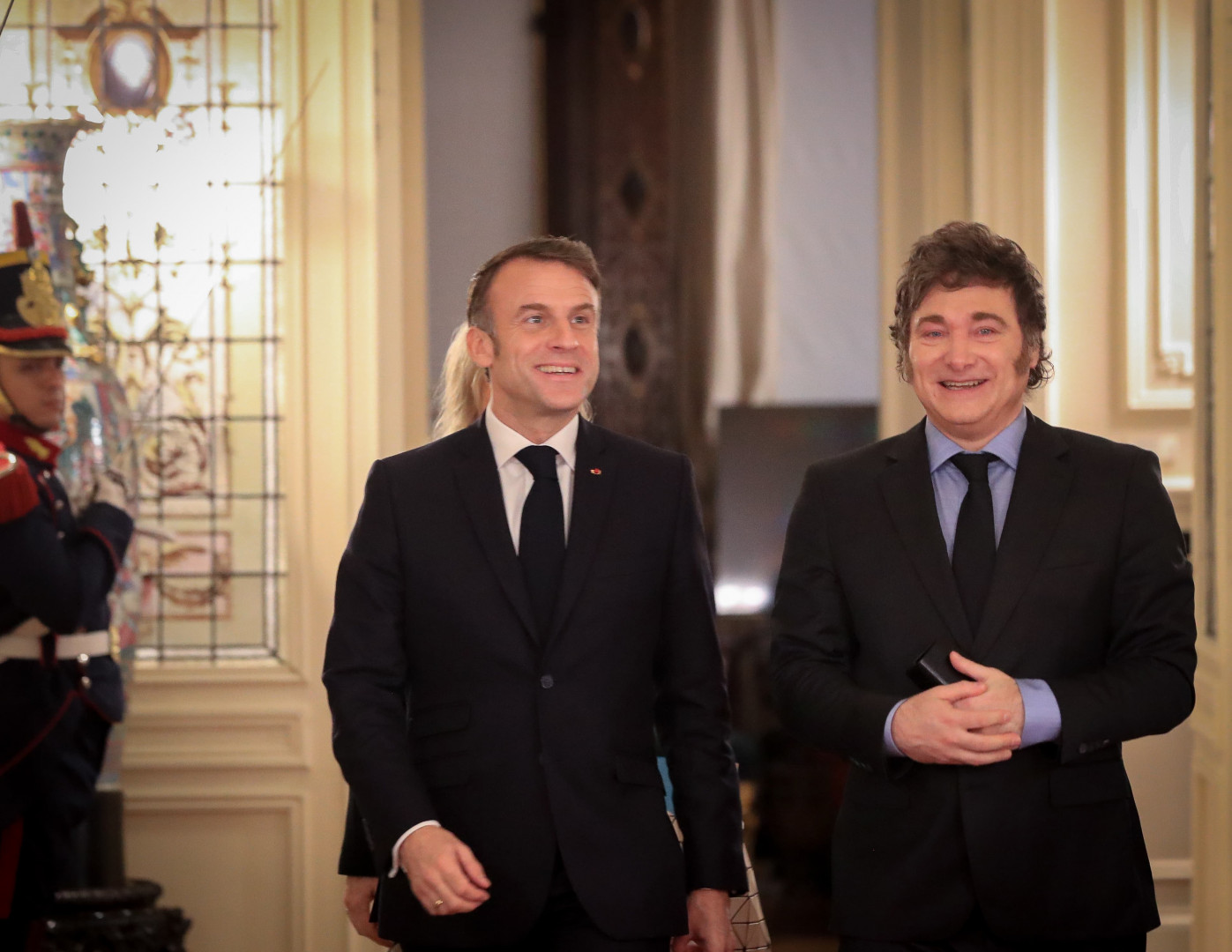
El mandatario francés junto a su esposa Brigitte fueron recibidos por el Presidente Milei y por la Secretaria General de la Presidencia, Karina Milei.
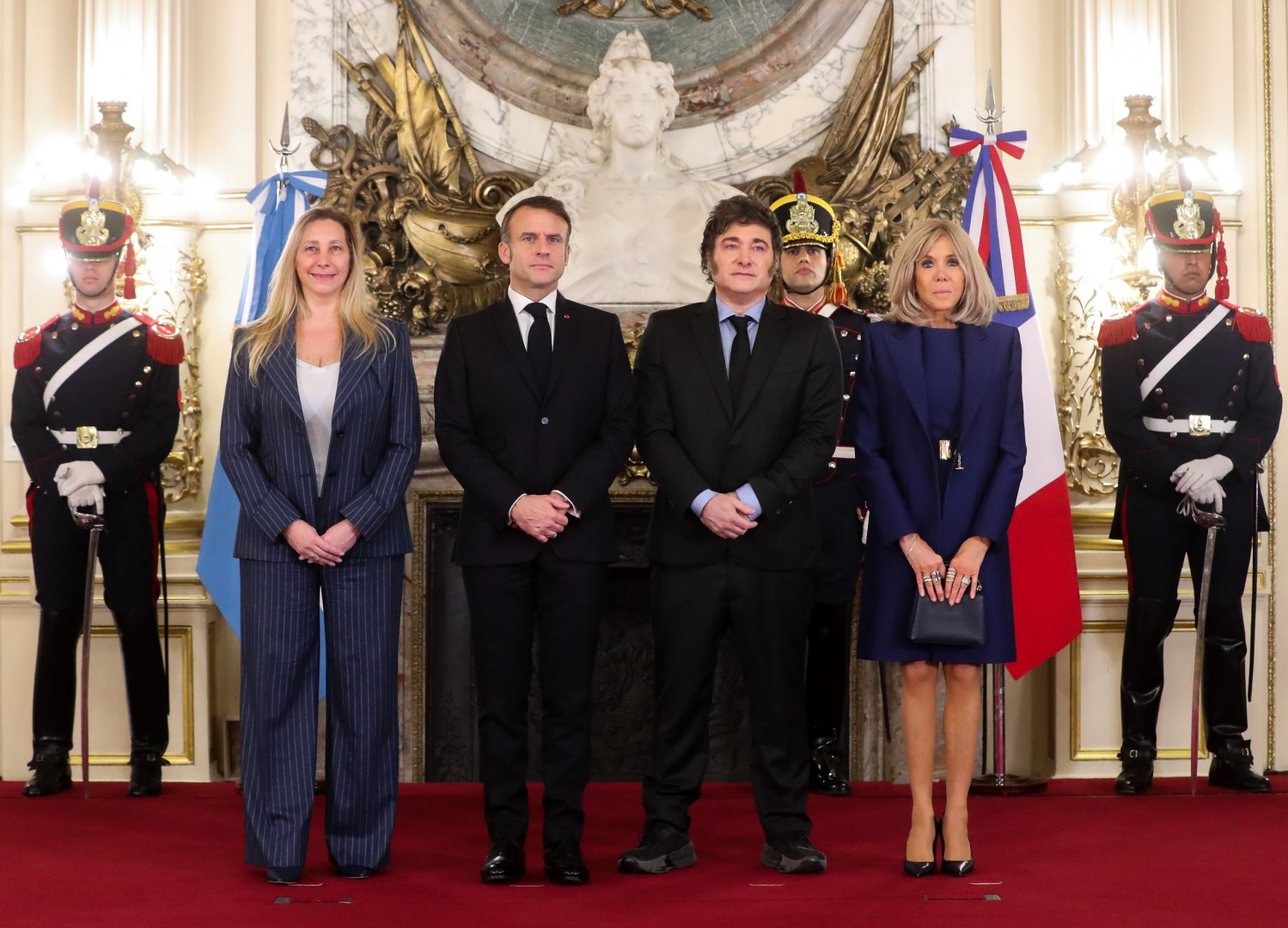
Ambos presidentes mantuvieron un reunión biateral en el Salón Eva Perón, y a su término, compartieron un encuentro con empresarios en el Salón de los Científicos.
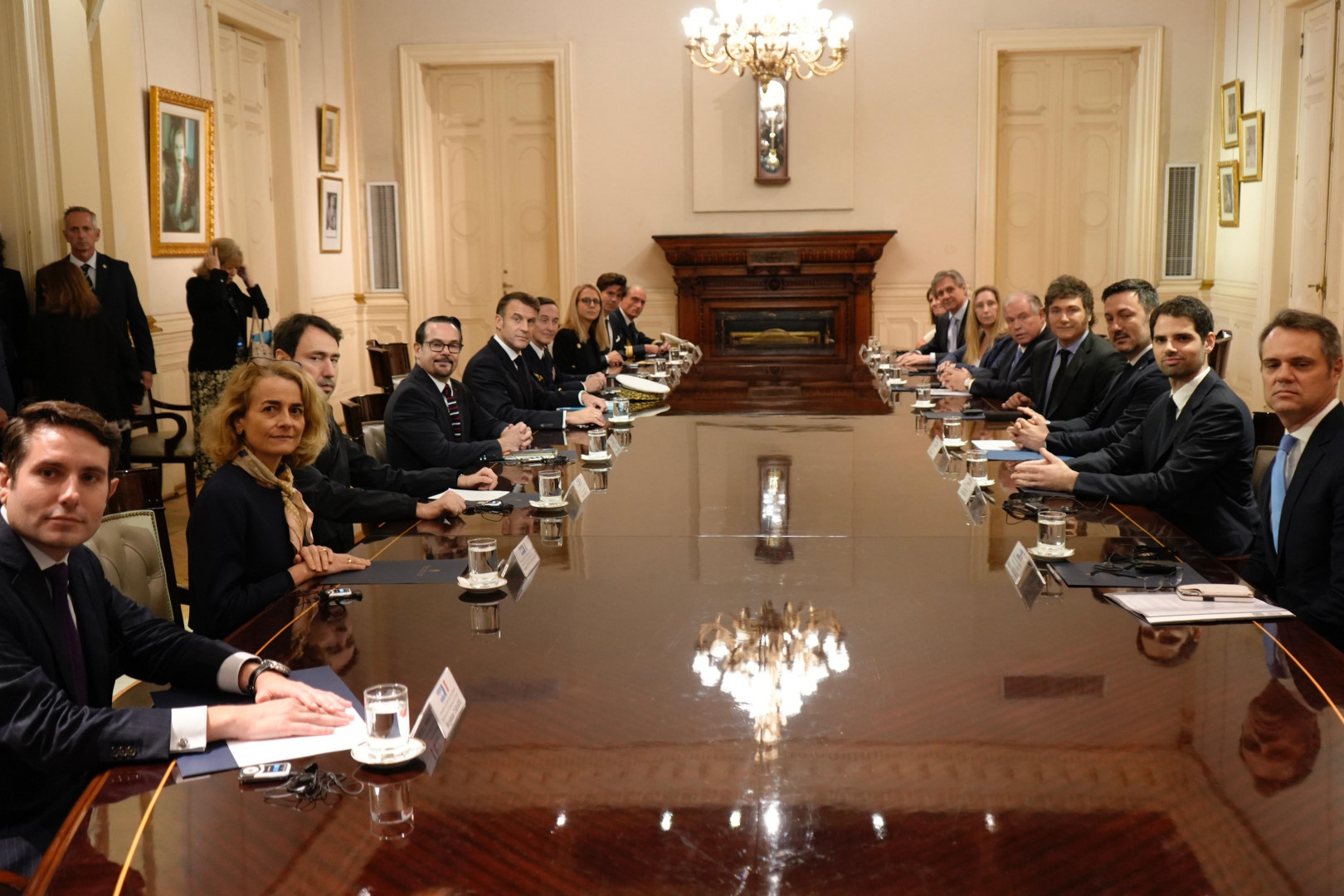
Los mandatarios saludaron desde el balcón de la Casa de Gobierno.
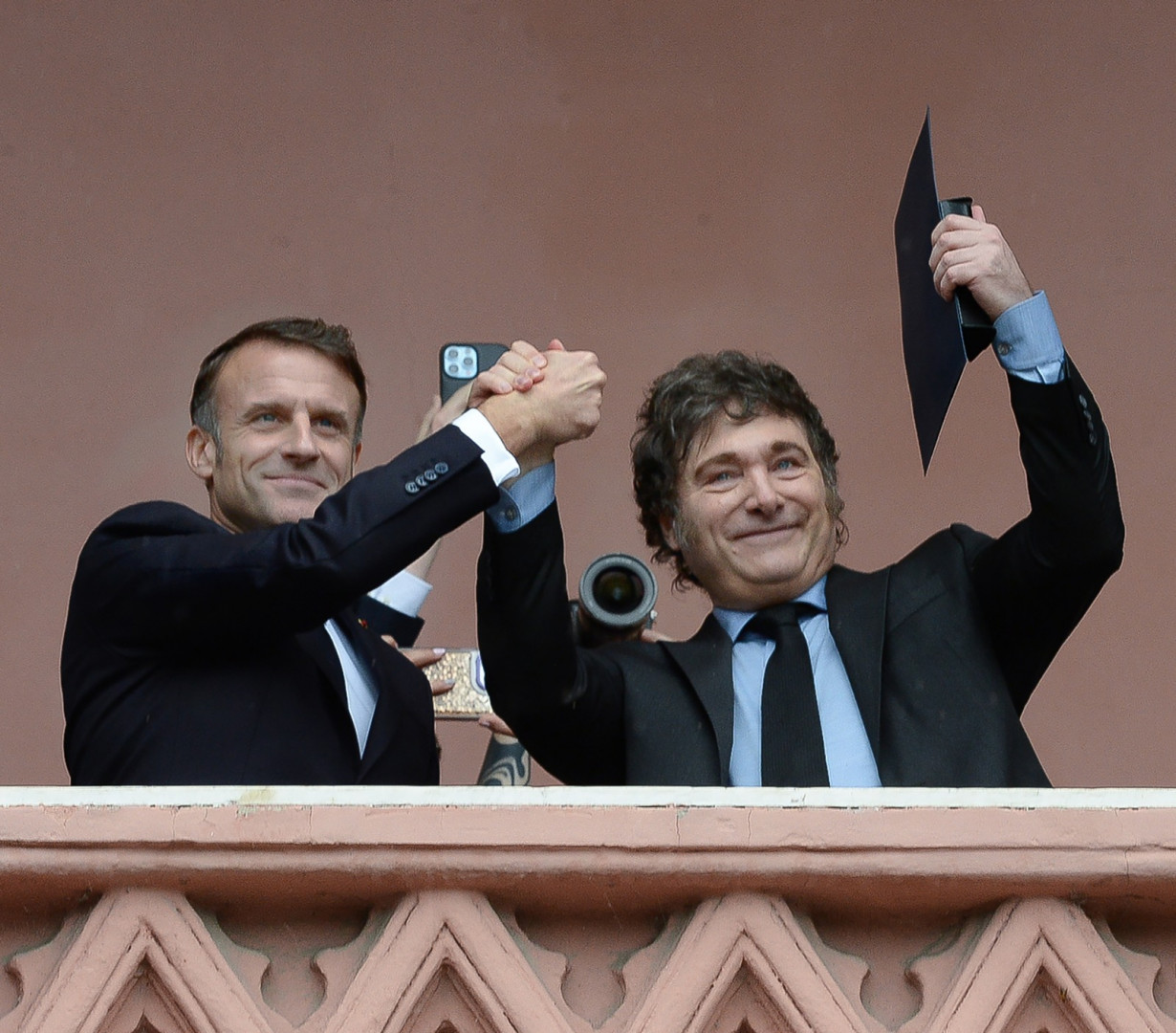
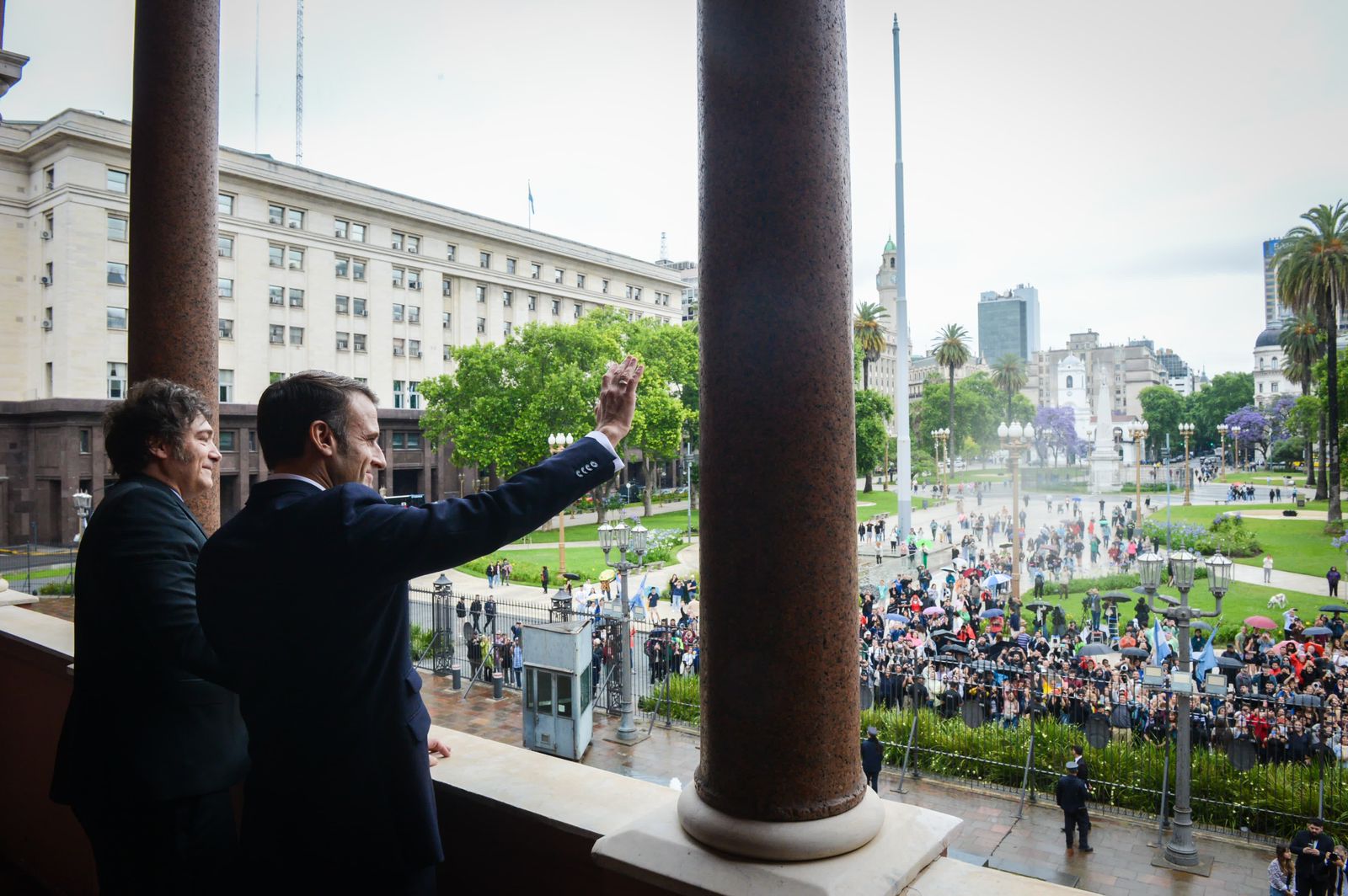
https://www.argentina.gob.ar/noticias/javier-milei-recibio-al-presidente-emmanuel-macron |
|
|
|
Réponse |
Message 33 de 42 de ce thème |
|
|
|
|
Réponse |
Message 34 de 42 de ce thème |
|
|
|
|
Réponse |
Message 35 de 42 de ce thème |
|
June 22 DC Metro subway trains collide - 9 dead, 80 injured
Timeline:
June 18-24: Gov. Sanford missing/crying in Argentina
June 21: 'Impact' Part 1 on ABC; Prince William birthday
June 22: DC Metro Red Line trains in collision
June 23: US Moon probes (LRO/LCROSS) reach Moon
June 24: Gov. Sanford reveals Argentine affair
June 25: Death of Michael Jackson & Farahh Fawcett
'Metro' means 'meter' in Spanish, Italian, Portuguese, etc. The meter is historically defined as 1/10,000,000 of the distance between the North Pole and the equator through Paris, or in other words the Paris Meridian between the North Pole and the equator. The Paris Meridian is also the 'Rose Line' (an esoteric concept popularized by The Da Vinci Code) i.e. a 'Red Line'...

DC Metro Red Line = French/Columbian Rose Line
...traditionally implying the Blood Royal/Sangraal or the Marian/Columbian Bloodline of the Holy Grail.
In Bloodline of the Holy Grail Laurence Gardner writes of the House of Stuart, the royal bloodline to which Princess Diana and her children belong (pp. 344-5):
https://www.goroadachi.com/etemenanki/moonwalker.htm |
|
|
|
Réponse |
Message 36 de 42 de ce thème |
|
France’s Macron and Pope Francis hold unusually long meeting
Updated 26 June 2018
REUTERS
June 26, 201812:24
1277
- Macron and Pope Francis spoke for nearly an hour in the Vatican’s Apostolic Palace
- The two discussed “protection of the environment, migration, and commitment to conflict prevention and resolution"
VATICAN CITY: French President Emmanuel Macron, accused at home of straining France’s secular foundations by seeking to mend ties with the Catholic Church, had an unusually long and cordial meeting with Pope Francis on Tuesday.
They spoke for nearly an hour in the official papal library in the Vatican’s Apostolic Palace, about twice as long as Francis usually spends with heads of state or government.
A Vatican statement said the two discussed “protection of the environment, migration, and multilateral commitment to conflict prevention and resolution, especially in relation to disarmament.”
They also spoke about prospects for resolving conflicts in the Middle East and Africa and the future of Europe, it said.
At the end of the private part of the audience, Macron gave Francis a rare copy of Goerges Bernanos 1936 book “Diary of a Country Priest.”
“I’ve read this book many times and it has done me good. It is a book that I have always loved very much,” the pope told Macron, 40, who was accompanied in the public parts of the meeting by his wife Brigitte, 65.
Francis gave Macron a medallion depicting Martin of Tours, a 4th century saint who is depicted cutting his cloak in half to give it to a beggar in winter.
“This means the vocation of those who govern is to help the poor. We are all poor,” Francis told Macron as he was giving him the medallion.
As Macron left the library, he and Francis exchanged a two-cheek kiss, another very usually gesture between a pope and a visiting head of state.
The Vatican was expected to issue a statement later on the themes discussed during the private talks.
Two months ago, Macron called for stronger ties between the state and the Catholic Church, a move critics said blurred a line that has kept French government free of religious intervention for generations.
The issue is particularly sensitive in historically Catholic France, where matters of faith and state were separated by law in 1905 and which is now home to Europe’s largest Muslim and Jewish communities.
France’s guiding principles also hold that religious observance is a private matter, for all faiths.
Macron was raised in a non-religious family and was baptized a Roman Catholic at his own request when he was 12.
On Tuesday afternoon Macron was due to be installed as the “First and Only Honorary Canon” of the Rome Basilica of St. John’s in Lateran, which is the pope’s cathedral in his capacity as bishop of Rome.
Under a tradition that began in the 15th century when France was a monarchy, French leaders are automatically given the title.
https://www.arabnews.com/node/1328511/world |
|
|
|
Réponse |
Message 37 de 42 de ce thème |
|

France’s Macron and Pope Francis hold unusually long meeting
Updated 26 June 2018
REUTERS
June 26, 201812:24
1277
- Macron and Pope Francis spoke for nearly an hour in the Vatican’s Apostolic Palace
- The two discussed “protection of the environment, migration, and commitment to conflict prevention and resolution"
VATICAN CITY: French President Emmanuel Macron, accused at home of straining France’s secular foundations by seeking to mend ties with the Catholic Church, had an unusually long and cordial meeting with Pope Francis on Tuesday.
They spoke for nearly an hour in the official papal library in the Vatican’s Apostolic Palace, about twice as long as Francis usually spends with heads of state or government.
A Vatican statement said the two discussed “protection of the environment, migration, and multilateral commitment to conflict prevention and resolution, especially in relation to disarmament.”
They also spoke about prospects for resolving conflicts in the Middle East and Africa and the future of Europe, it said.
At the end of the private part of the audience, Macron gave Francis a rare copy of Goerges Bernanos 1936 book “Diary of a Country Priest.”
“I’ve read this book many times and it has done me good. It is a book that I have always loved very much,” the pope told Macron, 40, who was accompanied in the public parts of the meeting by his wife Brigitte, 65.
Francis gave Macron a medallion depicting Martin of Tours, a 4th century saint who is depicted cutting his cloak in half to give it to a beggar in winter.
“This means the vocation of those who govern is to help the poor. We are all poor,” Francis told Macron as he was giving him the medallion.
As Macron left the library, he and Francis exchanged a two-cheek kiss, another very usually gesture between a pope and a visiting head of state.
The Vatican was expected to issue a statement later on the themes discussed during the private talks.
Two months ago, Macron called for stronger ties between the state and the Catholic Church, a move critics said blurred a line that has kept French government free of religious intervention for generations.
The issue is particularly sensitive in historically Catholic France, where matters of faith and state were separated by law in 1905 and which is now home to Europe’s largest Muslim and Jewish communities.
France’s guiding principles also hold that religious observance is a private matter, for all faiths.
Macron was raised in a non-religious family and was baptized a Roman Catholic at his own request when he was 12.
On Tuesday afternoon Macron was due to be installed as the “First and Only Honorary Canon” of the Rome Basilica of St. John’s in Lateran, which is the pope’s cathedral in his capacity as bishop of Rome.
Under a tradition that began in the 15th century when France was a monarchy, French leaders are automatically given the title.
https://www.arabnews.com/node/1328511/world |
|
|
|
Réponse |
Message 38 de 42 de ce thème |
|
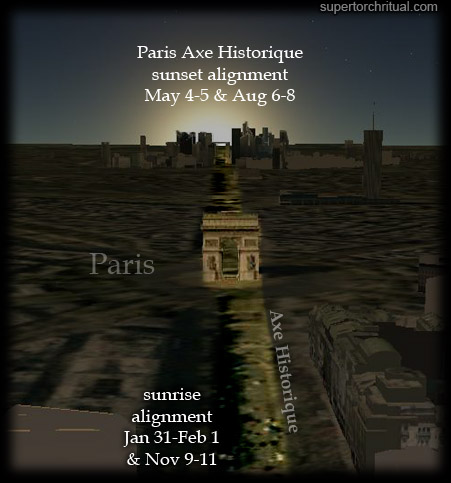

France’s Macron and Pope Francis hold unusually long meeting
Updated 26 June 2018
REUTERS
June 26, 201812:24
1277
- Macron and Pope Francis spoke for nearly an hour in the Vatican’s Apostolic Palace
- The two discussed “protection of the environment, migration, and commitment to conflict prevention and resolution"
VATICAN CITY: French President Emmanuel Macron, accused at home of straining France’s secular foundations by seeking to mend ties with the Catholic Church, had an unusually long and cordial meeting with Pope Francis on Tuesday.
They spoke for nearly an hour in the official papal library in the Vatican’s Apostolic Palace, about twice as long as Francis usually spends with heads of state or government.
A Vatican statement said the two discussed “protection of the environment, migration, and multilateral commitment to conflict prevention and resolution, especially in relation to disarmament.”
They also spoke about prospects for resolving conflicts in the Middle East and Africa and the future of Europe, it said.
At the end of the private part of the audience, Macron gave Francis a rare copy of Goerges Bernanos 1936 book “Diary of a Country Priest.”
“I’ve read this book many times and it has done me good. It is a book that I have always loved very much,” the pope told Macron, 40, who was accompanied in the public parts of the meeting by his wife Brigitte, 65.
Francis gave Macron a medallion depicting Martin of Tours, a 4th century saint who is depicted cutting his cloak in half to give it to a beggar in winter.
“This means the vocation of those who govern is to help the poor. We are all poor,” Francis told Macron as he was giving him the medallion.
As Macron left the library, he and Francis exchanged a two-cheek kiss, another very usually gesture between a pope and a visiting head of state.
The Vatican was expected to issue a statement later on the themes discussed during the private talks.
Two months ago, Macron called for stronger ties between the state and the Catholic Church, a move critics said blurred a line that has kept French government free of religious intervention for generations.
The issue is particularly sensitive in historically Catholic France, where matters of faith and state were separated by law in 1905 and which is now home to Europe’s largest Muslim and Jewish communities.
France’s guiding principles also hold that religious observance is a private matter, for all faiths.
Macron was raised in a non-religious family and was baptized a Roman Catholic at his own request when he was 12.
On Tuesday afternoon Macron was due to be installed as the “First and Only Honorary Canon” of the Rome Basilica of St. John’s in Lateran, which is the pope’s cathedral in his capacity as bishop of Rome.
Under a tradition that began in the 15th century when France was a monarchy, French leaders are automatically given the title.
https://www.arabnews.com/node/1328511/world
|
|
|
|
Réponse |
Message 39 de 42 de ce thème |
|
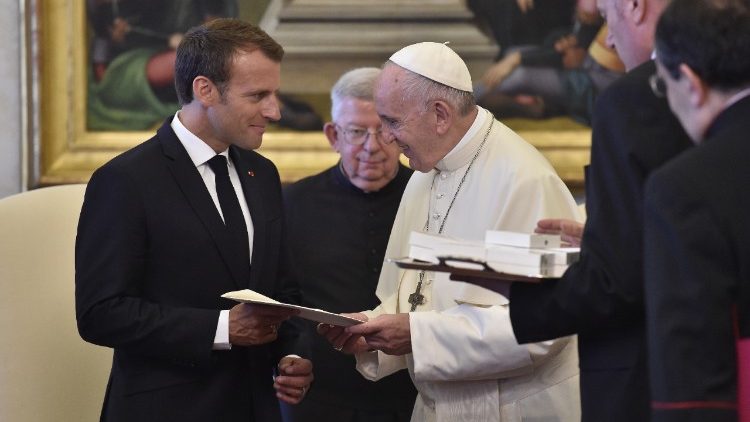 Pope exchanges gifts with French President Macron Pope exchanges gifts with French President Macron
Pope Francis meets French President Macron
At a private audience in the Vatican’s Apostolic Palace on Tuesday, Pope Francis and France’s president, Emmanuel Macron, exchange gifts and discuss the environment, migration, and disarmament.
By Devin Watkins
Pope Francis met on Tuesday with French President Emmanuel Macron, who later inherited the title of honorary canon of the Lateran Basilica. Macron was accompanied at the papal audience by his wife, Brigitte.
The Pope and the French president discussed protection of the environment, migration, and conflict prevention, according to a communique from the Holy See Press Office.
Their comments on global issues included the need for “multilateral commitment to conflict prevention and resolution, especially in relation to disarmament.”
Each one shared their views on conflicts in the Middle East and Africa, and reflected on the “prospects of the European project.”
Pope Francis and President Macron talked about how religions contribute to “the common good” of France, especially the Catholic Church’s commitment to bettering society.
Exchange of gifts
The two men exchanged gifts, with Pope Francis giving Macron, who was baptized a Catholic at the age of 12, a medallion of St. Martin of Tours, depicted cutting his cloak in half to give it to a beggar in winter.
President Macron gave the Pope a rare copy of Georges Bernanos’ 1936 book “Diary of a Country Priest”.
Afterwards, President Macron met with Cardinal Secretary of State Pietro Parolin and Archbishop Paul Richard Gallagher, Secretary for Relations with States.
Honorary Canon of Lateran Basilica
Later in the afternoon, Emmanuel Macron received the title “First and Only Honorary Canon” of the Basilica of St. John Lateran, the Cathedral of Rome.
French leaders automatically inherit the title of “Honorary Canon” under a tradition that dates back to the 15th century when France was a monarchy. Cardinal-elect Angelo De Donatis presided over the ceremony and conferred the title on President Macron.
https://www.vaticannews.va/en/pope/news/2018-06/pope-francis-france-president-macron-audience.html |
|
|
|
Réponse |
Message 40 de 42 de ce thème |
|


 
Pope Francis delivered a speech too progressive for Obama to give
Sep 24, 2015, 4:20 PM GMT-3
Pope Francis waves to the crowd from the Speakers Balcony at the US Capitol, September 24, 2015, in Washington, DC. Pool/Getty Images
If President Barack Obama had delivered the text of Pope Francis’s speech to Congress Thursday as a State of the Union address, he would have risked being denounced by Republicans as a socialist.
While most Republicans chose not to complain, and Democrats tried not to gloat, Francis’s speech to Congress was stunning in the breadth, depth, and conviction of its progressivism. That might not have been fully and immediately appreciated by everyone in the House chamber because the combination of Francis’s sotto voce delivery and his heavily accented English made it difficult, lawmakers said, to grasp everything he was saying.
But there was no mistaking his thrust. He made detailed arguments for openness to immigrants, addressing the human roots of climate change, closing the gap between the rich and the poor, and ending the death penalty — all of which invigorated the Democrats in the room.
“It was pretty progressive. He had a little right-to-life stuff in it,” Rep. James Clyburn, the third-ranking House Democrat, said as he cracked a smile thinking about how Republicans would receive the speech. “That’s enough for them.”
The pope isn’t going to change many hearts and minds in the badly divided Congress, lawmakers said, but the moment provided a brief respite from political warfare. Several presidential candidates, including Sens. Bernie Sanders, Lindsey Graham, Marco Rubio, and Ted Cruz, as well as Ben Carson, attended.
Rubio, a Roman Catholic, said in a brief interview that Francis “struck the right tone.” Sanders, a self-described socialist, seemed to like the content even more.
“Pope Francis is clearly one of the important religious and moral leaders not only in the world today but in modern history,” he said in a statement released after the speech. “He forces us to address some of the major issues facing humanity: war, income and wealth inequality, poverty, unemployment, greed, the death penalty and other issues that too many prefer to ignore.”
Democrats were eager enough to present Congress as united that they joined a Republican-led standing ovation when Francis told lawmakers of “our responsibility to protect and defend human life at every state of its development.” Several of them said it was out of respect for the pope. But there was another good reason: It strengthened the perception that the whole speech — most of which they liked — carried unifying themes.
Unity was good for Democrats because the speech favored their policies
Francis was interrupted a few times by whoops from the Democratic side of the chamber — by Steve Cohen, a Jewish Memphis Democrat who got excited about Francis’s mention of the Golden Rule; by New York’s Nydia Velázquez when he called for an end to the death penalty; and by Philadelphia Rep. Chaka Fattah when he mentioned his upcoming visit to that city. The Republicans in the room were a bit more staid. Cruz often appeared unmoved during moments when Rubio, who was sitting nearby, applauded. That was the case when Francis asked whether the greater opportunities sought by past generations of immigrants are “not what we want for our own children?”
It was a home crowd. Rep. Paul Gosar (R-AZ) had announced he would boycott the event over climate change, and there was a brief murmur when it became obvious that three conservative Catholic Supreme Court justices — Antonin Scalia, Samuel Alito, and Clarence Thomas — had not shown up. But it seemed that everyone in attendance just wanted to catch a glimpse of Francis and hear what he had to say.
Big-name guests filed into the public galleries above the House chamber long before the pope’s arrival: Former House Speaker Newt Gingrich, former Rep. Gabby Giffords, mega-donor Tom Steyer, and Carson. House members filled the seats in their chamber, followed by the Senate and four Supreme Court justices. At about a minute past 10 am, Francis strode down the center aisle of the House chamber, clad in his familiar white robe and skullcap.
Lawmakers, who had been admonished not to touch the pope, refrained from trying to shake his hand or pat his back. There was no rush to crowd him the way members of Congress try to get into pictures with the president during the annual State of the Union address. When he got to the end of the aisle, he quietly shook hands with Secretary of State John Kerry and then made his way to the rostrum.
Samantha Power, the US ambassador to the UN, pulled out a baby blue iPhone and began snapping pictures. Though she later took to Twitter to commemorate the moment, Power hadn’t posted any of her photos by midday.
For his part, Francis warmed up the audience by describing America as “the land of the free and the home of the brave.” He was slow to move into more politically charged territory but unimpeded when he did. There were 10 standing ovations after his initial greeting, and they were bipartisan.
Francis tackled tough issues at the heart of the US political debate and gently admonished lawmakers to build bridges
At times, Francis seemed to be speaking directly into the headlines and newscasts of the day.
Less than a week after Carson said that America shouldn’t elect a Muslim president, Francis warned that “a delicate balance is required to combat violence perpetrated in the name of a religion, an ideology or an economic system, while also safeguarding religious freedom, intellectual freedom and individual freedoms.”
As Republican presidential frontrunner Donald Trump promises to build a wall between Mexico and the US, and to prevent Syrian refugees from being admitted to America, Francis compared the current refugee crisis to the one that arose in World War II and said that “we the people of this continent are not fearful of foreigners, because most of us were once foreigners.” That drew a standing ovation. Rubio, who has shifted his emphasis on immigration reform over time, leaped to his feet.
And while Democrats continue to bask in this summer’s Supreme Court decision protecting same-sex marriage, the pope said he was concerned that “fundamental relationships are being called into question, as is the very basis of marriage and the family.” The issue that caused the biggest stir before the speech — climate change — factored prominently in Francis’s remarks. He spoke of the human roots of global warming and said, “I am convinced we can make a difference.”
But perhaps the most unexpected run in the speech was an admonishment as gentle as it was clear: Politics is about building bridges, not destroying them. Francis never mentioned the international nuclear nonproliferation deal with Iran by name or the gridlock in American politics, but he seemed to be speak to both matters.
“When countries which have been at odds resume the path of dialogue — a dialogue which may have been interrupted for the most legitimate of reasons — new opportunities open up for all,” he said. “A good political leader is one who, with the interests of all in mind, seizes the moment in a spirit of openness and pragmatism. A good political leader always opts to initiate processes rather than possessing spaces.”
Pennsylvania Republican Rep. Joe Pitts, speaking about the pope’s limited remarks on abortion and same-sex marriage, said he was displeased that Francis had been “unfortunately politically correct.”
For liberals, though, he was simply correct about politics.
https://www.vox.com/2015/9/24/9393731/pope-francis-speech-progressive-obama
|
|
|
|
Réponse |
Message 41 de 42 de ce thème |
|
https://www.lanacion.com.ar/lifestyle/quien-fue-san-martin-de-tours-el-patrono-de-la-ciudad-de-buenos-aires-nid11112023/ |
|
|
|
Réponse |
Message 42 de 42 de ce thème |
|
Plaza San Martín de Tours (Buenos Aires)
 Vista de la barranca de la plaza de San Martín de Tours, tomada desde la calle Posadas entre Adolfo Bioy Casares (ex Schiaffino) y la bajada de la avenida Alvear  Extremo sur de la plaza, en la intersección de la avenida Alvear y la calle Adolfo Bioy Casares
La plaza de San Martín de Tours es un espacio verde ubicado en el barrio de Recoleta de la ciudad de Buenos Aires, Argentina. Forma parte de un amplio conjunto de plazas que conforma el tradicional Paseo de la Recoleta. Se encuentra delimitada por las calles de Eduardo Adolfo de Bioy Casares (ex Schiaffino), Posadas y la avenida Alvear,1 que en su desembocadura a la avenida del Libertador bordea los márgenes sur y oeste de la plaza. Frente a su margen norte, cruzando la calle Posadas, se ubican el monumento ecuestre a Carlos María de Alvear y el edificio del Palais de Glace. Recibió el nombre en 1962 en homenaje a San Martín de Tours, patrono de Buenos Aires, por decreto del entonces intendente Alberto Prebisch.2
 Monumento a San Martín de Tours  El monumento a Alvear en la década de 1930. A la derecha se aprecia la parte inferior de la plaza
La fisonomía de la plaza está marcada por una ladera que desciende hacia la calle Posadas, parte de la barranca ribereña histórica del Río de la Plata. En el bajo se ubica un ombú de gran porte, mientras que la zona elevada forma una terraza donde se encuentran plantados varios especímenes de gomero, retoños del ubicado en la cercana plaza de Juan XXIII. Hacia la esquina de la avenida Alvear y la calle Schiaffino se encuentra una monumento en homenaje al ingeniero y periodista Emilio Mitre realizado en mármol de Carrara con basamento de granito, obra del escultor Hernán Cullen Ayerza emplazada allí en 1931.3 También en la porción superior de la plaza se ubica un monumento a San Martín de Tours realizado en bronce, del escultor Ermando Bucci.4
Los terrenos que hoy ocupa la plaza de San Martín de Tours formaron históricamente parte de la zona de quintas de la Recoleta, usándose para el cultivo de especies frutales y la cría de animales domésticos. Hasta el último cuarto del siglo xix, antes de que la epidemia de fiebre amarilla de 1871 llevara a la aristocracia porteña a abandonar el Barrio Sur, fue una zona marginal de las afueras de la ciudad. Excavaciones realizadas por un equipo de arqueología urbana encontraron restos de un pozo y materiales que señalan la existencia de viviendas de construcción precaria.5 Con la redistribución sociodemográfica ocurrida tras la epidemia, los alrededores de la plaza se poblaron a fines de siglo de elaborados palacetes en estilo academicista francés. A principios del siglo xx existió en el sector de la plaza cercano a la avenida Alvear el Recreo de Belvedere, café y restaurante donde por primera vez se habría bailado públicamente el tango. En 1909 el terreno fue adquirido por la Municipalidad, que dispuso su parquización.6
La normativa es inconsistente con respecto a la catalogación del espacio verde. Algunos registros legales de la Ciudad Autónoma de Buenos Aires refieren a la plaza de San Martín de Tours mientras que en ocasiones es mencionada como una plazoleta.1
|
|
|
 Premier Premier
 Précédent
28 a 42 de 42
Suivant Précédent
28 a 42 de 42
Suivant
 Dernier
Dernier

|
|
| |
|
|
©2025 - Gabitos - Tous droits réservés | |
|
|


















